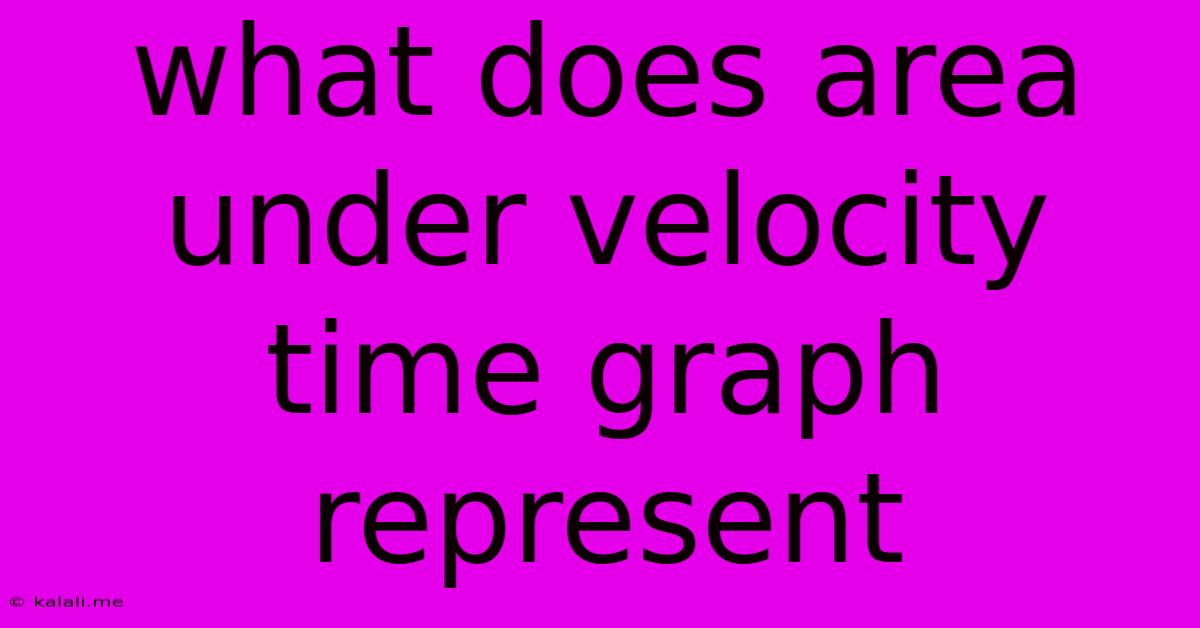What Does Area Under Velocity Time Graph Represent
Kalali
Jun 15, 2025 · 3 min read

Table of Contents
What Does the Area Under a Velocity-Time Graph Represent?
The area under a velocity-time graph represents the displacement of an object. This is a fundamental concept in kinematics and understanding it is crucial for solving various physics problems. This article will explore why this is the case, providing a clear explanation and examples. Understanding this relationship is key to mastering motion analysis.
Understanding Velocity and Displacement
Before diving into the graph itself, let's clarify the terms:
-
Velocity: Velocity is a vector quantity, meaning it has both magnitude (speed) and direction. It describes how quickly an object's position is changing. A positive velocity indicates movement in a positive direction, while a negative velocity indicates movement in the opposite direction.
-
Displacement: Displacement is also a vector quantity representing the change in an object's position from its starting point to its final point. It's the shortest distance between the initial and final positions, considering direction. This is different from distance traveled, which is a scalar quantity (only magnitude).
Connecting the Graph to Displacement
The velocity-time graph plots velocity on the y-axis and time on the x-axis. Consider a small interval of time, Δt. During this interval, let's assume the velocity is constant at v. The displacement (Δs) during this interval is simply:
Δs = v * Δt
Notice that this is the area of a rectangle with height v and width Δt. This is the key insight!
If the velocity isn't constant, we can break the area under the curve into many small rectangles, each representing the displacement during a small time interval. By summing the areas of all these rectangles, we obtain an approximation of the total displacement.
As we make the time intervals smaller and smaller (approaching zero), the approximation becomes more accurate. In the limit, the sum of the areas of these infinitesimally small rectangles becomes the definite integral of the velocity function with respect to time.
Mathematical Representation
Mathematically, the displacement (s) is given by:
s = ∫v(t) dt
where v(t) is the velocity as a function of time, and the integral is taken over the relevant time interval.
Examples
Let's illustrate with some examples:
-
Constant Velocity: If the velocity is constant, the velocity-time graph is a horizontal line. The area under the line is a rectangle, and its area (and thus the displacement) is simply velocity multiplied by time.
-
Uniform Acceleration: If the object is undergoing uniform acceleration, the velocity-time graph is a straight line with a non-zero slope. The area under the line is a triangle (or trapezoid if the initial velocity is not zero), and its area can be calculated using the appropriate geometric formula. This corresponds to the equations of motion learned in introductory physics.
-
Non-Uniform Acceleration: For more complex motion involving non-uniform acceleration, the area under the velocity-time curve needs to be calculated using integration techniques. This often involves more advanced calculus.
In Conclusion
The area under a velocity-time graph is a powerful tool for determining an object's displacement. Understanding this fundamental relationship is essential for analyzing motion in various contexts, from simple linear motion to more complex scenarios involving varying accelerations. By mastering this concept, you'll enhance your understanding of kinematics and problem-solving abilities in physics.
Latest Posts
Latest Posts
-
List Of Sports Cups And Trophies
Jun 15, 2025
-
Bank Account Closing Letter Word Format
Jun 15, 2025
-
The First Five Multiples Of 9
Jun 15, 2025
-
What Is The Factor Of 112
Jun 15, 2025
-
Difference Between Electron Affinity And Electronegativity
Jun 15, 2025
Related Post
Thank you for visiting our website which covers about What Does Area Under Velocity Time Graph Represent . We hope the information provided has been useful to you. Feel free to contact us if you have any questions or need further assistance. See you next time and don't miss to bookmark.